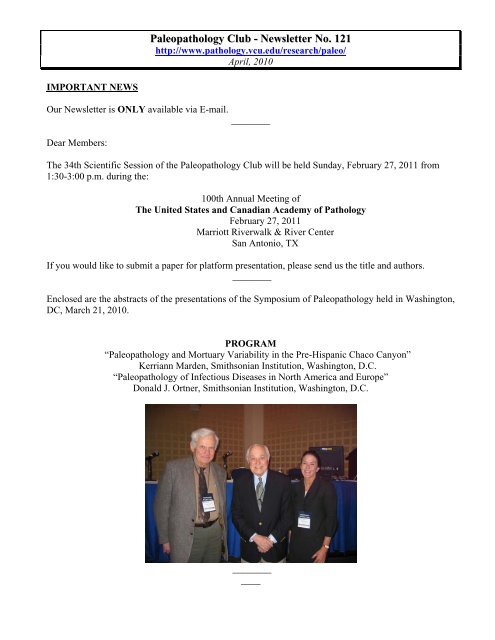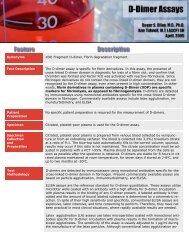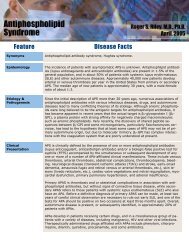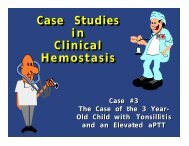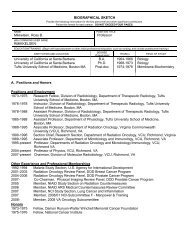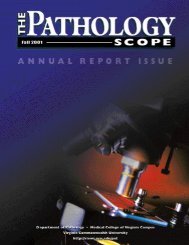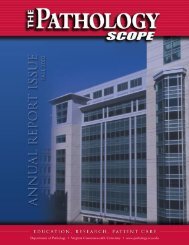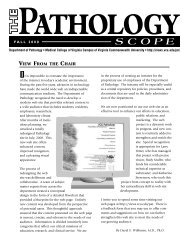Newsletter No. 121 - Pathology - Virginia Commonwealth University
Newsletter No. 121 - Pathology - Virginia Commonwealth University
Newsletter No. 121 - Pathology - Virginia Commonwealth University
Create successful ePaper yourself
Turn your PDF publications into a flip-book with our unique Google optimized e-Paper software.
Paleopathology Club - <strong>Newsletter</strong> <strong>No</strong>. <strong>121</strong><br />
http://www.pathology.vcu.edu/research/paleo/<br />
April, 2010<br />
IMPORTANT NEWS<br />
Our <strong>Newsletter</strong> is ONLY available via E-mail.<br />
________<br />
Dear Members:<br />
The 34th Scientific Session of the Paleopathology Club will be held Sunday, February 27, 2011 from<br />
1:30-3:00 p.m. during the:<br />
100th Annual Meeting of<br />
The United States and Canadian Academy of <strong>Pathology</strong><br />
February 27, 2011<br />
Marriott Riverwalk & River Center<br />
San Antonio, TX<br />
If you would like to submit a paper for platform presentation, please send us the title and authors.<br />
________<br />
Enclosed are the abstracts of the presentations of the Symposium of Paleopathology held in Washington,<br />
DC, March 21, 2010.<br />
PROGRAM<br />
“Paleopathology and Mortuary Variability in the Pre-Hispanic Chaco Canyon”<br />
Kerriann Marden, Smithsonian Institution, Washington, D.C.<br />
“Paleopathology of Infectious Diseases in <strong>No</strong>rth America and Europe”<br />
Donald J. Ortner, Smithsonian Institution, Washington, D.C.<br />
________<br />
____
April, 2010<br />
Page 2<br />
Case #116<br />
Diagnosis: Hansen’s disease (Leprosy).<br />
Because of the combination of remodeling of the margins of the piriform aperture with destructive<br />
remodeling of the anterior hard palate, the most likely diagnosis is leprosy. Treponematosis and<br />
tuberculosis can cause similar lesions but remodeling of the anterior hard palate would be unusual.<br />
Submitted by: Dr. Donald Ortner, National Museum of Natural History, Smithsonian Institution,<br />
Washington, DC.<br />
The answer to Case #116 can be viewed and printed in Internet Explorer 6.0 at:<br />
http://www.pathology.vcu.edu/paleo/case.116.html<br />
_______<br />
Case #117:<br />
History:<br />
Year 1900: 55-year-old male with a long history of chronic disease.<br />
Submitted by: Dr. Enrique Gerszten, <strong>Virginia</strong> <strong>Commonwealth</strong> <strong>University</strong>, Medical College of <strong>Virginia</strong><br />
Campus, Richmond, VA, USA.<br />
The slide of Case #117 can be best viewed and printed in Internet Explorer 6.0 at:<br />
http://www.pathology.vcu.edu/paleo/case.117.html<br />
_______<br />
<strong>No</strong>tice!<br />
If you have an interesting slide you would like to share with other members, please send it along with its<br />
history.<br />
Dr. Marvin J. Allison<br />
Dr. Enrique Gerszten<br />
<strong>Virginia</strong> <strong>Commonwealth</strong> <strong>University</strong><br />
<strong>Virginia</strong> <strong>Commonwealth</strong> <strong>University</strong><br />
Medical College of <strong>Virginia</strong> Campus<br />
Medical College of <strong>Virginia</strong> Campus<br />
Department of <strong>Pathology</strong><br />
Department of <strong>Pathology</strong><br />
Richmond, VA 23298 Richmond, VA 23298<br />
USA<br />
USA<br />
mallison@mcvh-vcu.edu<br />
egerszten2@mcvh-vcu.edu
Paleopathology and Mortuary Variability in the Pre-Hispanic Chaco Canyon<br />
Kerriann Marden, Smithsonian Institution, Washington, DC<br />
This presentation includes three cases of pathological conditions in skeletal remains from prehistoric<br />
Chaco Canyon, New Mexico, ca A.D. 850-950. These cases demonstrate the range of observable<br />
pathological conditions in this small burial population, and help to provide a sense of the health<br />
conditions at this prehistoric site. The first is an adult female who exhibits several skeletal lesions<br />
characteristic of treponemal infection, including stellate lesions on the cranial vault, a classic<br />
gummatous lesion on the tibial shaft, and lesions involving the nasopharynx and the clavicular shaft.<br />
The second individual is a very young adult female who has skeletal defects consistent with healed stage<br />
IV Legg-Calvé-Perthes disease. The capital femoral epiphysis is necrosed unilaterally, with significant<br />
remodeling of both the femoral head and acetabulum, although the capitus is in the correct anatomical<br />
position in relation to the femoral neck, and the neck length is normal. There are notable differences in<br />
shaft diameter between the affected leg and its unaffected antimere, consistent with muscular atrophy<br />
and altered gait expected with untreated Perthes’ disease.<br />
Lastly, a third individual exhibits a pair of circular, lytic foci on the cranial vault that probably result<br />
from a metastatic carcinoma. The proximal right femur from this individual also appears to show some<br />
osteoclastic activity in the cancellous bone, although there is also blastic periosteal reaction in this bone.<br />
These three cases are among several pathological conditions observed in this burial population, which,<br />
taken together, help to paint a clearer picture of life and death in the prehistoric Southwest. When these<br />
conditions are considered in relation to archaeological indicators of the method and location of disposal<br />
of the bodies, we can also glean cultural information about the perception of disease in Chaco Canyon.
SELECTED REFERENCES<br />
Aufderheide AC, Rodriguez Martin C. The Cambridge Encyclopedia of Human Paleopathology.<br />
Cambridge <strong>University</strong> Press. 1998.<br />
Brothwell D. Tumours and tumour-like processes. In: R. Pinhasi and S. Mays, eds. Advances in Human<br />
Palaeopathology. 2008. Chichester, Wiley. 253-281.<br />
Ortner DJ. Identification of Pathological Conditions in Human Skeletal Remains. 2nd ed. Academic<br />
Press. 2003.<br />
Resnick D. Osteochondroses. In: Bralow L, ed. Bone and Joint Imaging. 2nd ed. Philadelphia: WB<br />
Saunders Co.1996: 960-6.<br />
Wheeless CR. Legg Calve Perthes Disease. In: Wheeless' Textbook of Orthopaedics [online]. Available<br />
at: http://www.wheelessonline.com/ortho/legg_calve_perthes_disease. Accessed <strong>No</strong>v 18, 2009.
Paleopathology of Infectious Diseases in <strong>No</strong>rth America and Europe<br />
Donald J. Ortner, Ph.D., D.Sc.<br />
Department of Anthropology<br />
Smithsonian Institution<br />
Washington, DC 20560<br />
Evidence of infectious disease in archaeological human skeletal samples, when combined with<br />
cultural and other biological data, provides insight into the prevalence and significance of those diseases<br />
in the past. Unfortunately few infectious diseases affect the skeleton and those that do, affect relatively<br />
few patients who have one of the disorders. Infectious diseases that affect the skeleton tend to be<br />
chronic with long-term survival of the patient with the disease.<br />
Infectious disorders that can affect the skeleton and have been identified in archaeological human<br />
remains include: tuberculosis, leprosy, treponematosis, ulcer, brucellosis, osteomyelitis, periostitis and<br />
mycosis (Aufderheide and Rodríguez-Martin 1998; Ortner 2003). A major emphasis in my research for<br />
the past twenty years has been characterizing the skeletal manifestations of leprosy (e.g., Ortner 2002,<br />
2008) and brucellosis (Ortner 2003). I also have an ongoing research interest in treponematosis.<br />
In the research on the paleopathology of treponematosis, unfortunately in my opinion, there has been<br />
too much emphasis on where the venereal form originated. There has been inadequate emphasis on the<br />
pathogenesis of and relationship between the three syndromes (syphilis, yaws, bejel) that affect the<br />
skeleton. There is, however, increasing evidence for the presence of syphilis in the Old World well<br />
before 1500 AD.<br />
Differential diagnosis in human skeletal paleopathology is a challenging exercise. Fortunately the<br />
number of disorders that can affect the skeleton is a relatively small fraction of all the diseases that cause<br />
morbidity and mortality. Ongoing research on human skeletal paleopathology has made significant<br />
progress in clarifying the differences between infectious disorders that can affect the skeleton.<br />
Leprosy is one of the disorders that has received considerable emphasis over the past fifty years<br />
including the pioneer research of Møller-Christensen (1965, 1978). In my research on human remains<br />
from a medieval cemetery for patients with leprosy, very clear patterns of skeletal involvement occur<br />
and the diagnosis in most cases is almost certain.<br />
The history of leprosy in Europe is of considerable interest because of the decline and virtual<br />
disappearance of the disorder by about 1500 AD. The reason for this decline remains a matter of<br />
speculation that has important implications for our understanding of host/pathogen coevolution in<br />
infectious disease.
References<br />
Aufderheide A., and Rodríguez-Martín C. (1998). The Cambridge Encyclopedia of Human<br />
Paleopathology. Cambridge: Cambridge <strong>University</strong> Press.<br />
Møller-Christensen V. (1965). New Knowledge of leprosy through paleopathology. International<br />
Journal of Leprosy 33:603-610.<br />
Møller-Christensen V. (1978). Leprosy Changes of the Skull. Odense: Odense <strong>University</strong> Press.<br />
Ortner, D.J. (2002). Observations on the pathogenesis of skeletal disease in leprosy. In C.A. Roberts,<br />
M.E. Lewis and K. Manchester eds. The past and present of leprosy. Archaeological, historical,<br />
palaeopathological and clinical approaches. Oxford, Archaeopress pp. 73-80.<br />
Ortner, D. J. (2003). Identification of Pathological Conditions in Human Skeletal Remains, Second<br />
Edition. Amsterdam: Academic Press.<br />
Ortner, D.J. ( 2008). Skeletal manifestations of leprosy. In: John Magilton, Frances lee and Anthea<br />
Boylston. ‘Lepers Outside the Gate. Chichester Excavations 10, CBA Research Report 158, Council<br />
for British Archaeology. York: Council for British Archaeology pp. 198-207.


